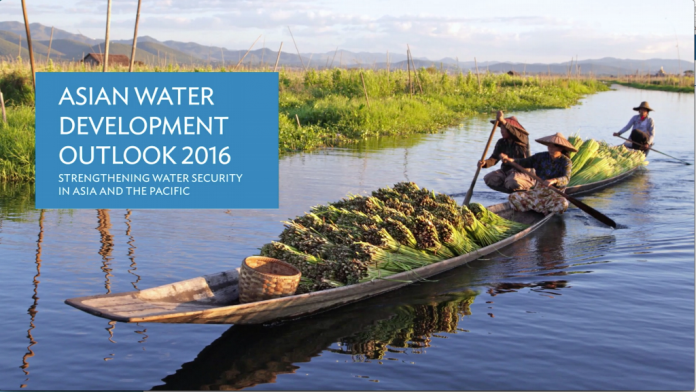
Water security in Asia and the Pacific has progressed overall in the past five years, but major challenges remain, including overexploited groundwater, demand from rising populations, and climate variability, according to a new report from the Asian Development Bank (ADB).
The new edition of the Asian Water Development Outlook (AWDO 2016) provides a snapshot of the water security status of 48 of the region’s countries, using latest data sets. According to these, the number of countries assessed as water insecure has dropped to 29, compared to 38 identified in the previous issue of the report in 2013.
“The improving trend in water security is encouraging for the region and mainly reflects investments made in water infrastructure, like access to piped water supply or drainage,” Yasmin Siddiqi, Principal Water Resources Specialist, Asian Development Bank, told The Source. “What we do understand is that there is a strong correlation between governance and water security, so the advanced economies like Australia, New Zealand and Singapore score high on governance and likewise on water security. It suggests that advancing in to higher water security therefore cannot be supported by infrastructure alone, but also requires efforts to improve governance.”
Water insecurity costs the global economy US$500 billion annually, or 1 percent of global gross domestic product. Water for agriculture in Asia and the Pacific consumes 80 percent of water resources, while 1.7 billion people lack access to basic sanitation, according to the report. With the region’s population predicted to top 5.2 billion by 2050, the water resources face enormous pressure as demand is predicted to increase by 55 percent in that time.
AWDO 2016 uses the latest available data to assess water security in five key dimensions including household, economic, urban, environment and resilience to water-related disasters. Advanced economies such as Australia, Japan and New Zealand consistently lead the way, followed by countries in East Asia—led by China, which has taken the biggest stride to improve water security since the AWDO 2013 edition.
“Asia and Pacific remains the world’s most vulnerable region to water insecurity and cannot sustain its recent high growth through provision of infrastructure alone,” said Bambang Susantono, ADB Vice- President for Knowledge Management and Sustainable Development. “Meeting the region’s socioeconomic challenges and achieving Sustainable Development Goal 6 on water will require bridging the gap in provision of water services between rich and poor in urban areas, and between rural and urban areas.”

On household access to piped potable water and improved sanitation, all regions of Asia improved their performance since 2013, except for the Pacific islands. But although the rural-urban gap has been reduced in some countries (such as Armenia and Thailand), major disparities remain between rural and urban areas and between rich and poor on services and infrastructure for piped water supply and sanitation. South Asian countries particularly need to make considerable efforts to improve their performance in this dimension.
On urban water security, East Asia has shown positive progress while South and Southeast Asia still have some way to go, particularly Myanmar, Pakistan, and the Philippines. Significant investment and leadership is needed to reliably meet the water needs of cities.
“Finding technical solutions is the task for engineers, what we are trained for,” added Siddiqi. “Reinforcing the investments in infrastructure for inclusiveness and sustainability within a conducive policy framework and healthy institution is very challenging. This requires us to think well beyond our engineering knowledge and tap into the minds of specialist partner agencies to bring in more multi-faceted solutions.”
In relation to resilience to water-related disasters, advanced economies show the strongest performance while much of the rest of Asia and the Pacific has been weak. Between 1995 and 2015, there were 2,495 water-related disasters striking Asia, killing 332,000 people and affecting a further 3.7 billion. South Asia showed the lowest resilience score, but several other countries showed strong improvement since 2013. These included Pakistan; the Philippines; and Taipei, China.
The report concludes there is a strong relationship between water management and the economy, and investments in good water management can be considered as a longer-term payback for increased growth and poverty reduction. Water-related investments can increase economic productivity and growth, while economic growth provides the resources to invest in institutions and capital-intensive water infrastructure.







